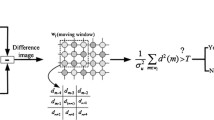Abstract
This paper presents a method for waterfront surveillance system. Unlike traditional approaches that model dynamic water background explicitly, we choose a relaxed background model to extract multiple object hypotheses. The hypotheses are then tracked with probablistic framework. Finally, the hypotheses are classified as positive objects or negative objects based on their trackability. Trackability is described by the stableness and the consistency of their trajectories and their appearances, and the properties of their accumulated templates.
Similar content being viewed by others
References
Baker S., Matthews I.: Lucas-kanade 20 years on: A unifying framework. IJCV. 56(3), 221–255 (2004)
Burges C.J.C.: A tutorial on support vector machines for pattern recognition. Data Min. Knowl. Discov. 2(2), 121–167 (1998)
Doretto G., Chiuso A., Wu Y.N., Soatto S.: Dynamic textures. IJCV. 51(2), 91–109 (2003)
Eng, H.-L., Wang, J., Kam, A.H., Yau, W.-Y.: Novel region-based modeling for human detection within highly dynamic aquatic environment. In: CVPR, vol. 2, pp. 390–397 (2004)
Gracia-Roche, J.J., Orrite-Uruñuela, C., Martínez del Rincón, J., Herrero-Jaraba, J.E.: Multimodal appearance distribution tracking. In: IEEE International Workshop on Performance Evaluation of Tracking and Surveillance, pp. 70–77 (2005)
Kadir T., Brady M.: Scale, saliency and image description. IJCV. 45(2), 83–105 (2001)
Kadir T., Zisserman A., Brady M.: An affine invariant salient region detector. ECCV. 1, 404–416 (2004)
Lindeberg T.: Feature detection with automatic scale selection. IJCV. 30(2), 79–116 (1998)
Lowe D.G.: Distinctive image features from scale-invariant keypoints. IJCV. 60(2), 91–110 (2004)
Lucas, B.D., Kanade, T.: An iterative image registration technique with an application to stereo vision (darpa). In: Proceedings of the 1981 DARPA Image Understanding Workshop, pp. 121–130, April 1981
Matas, J., Chum, O., Urban, M., Pajdla, T.: Robust wide baseline stereo from maximally stable extremal regions. BMVC (2002)
Mikolajczyk K., Schmid C.: Scale and affine invariant interest point detectors. IJCV. 60(1), 63–86 (2004)
Mittal, A., Paragios, N.: Motion-based background subtraction using adaptive kernel density estimation. In: CVPR, vol. 2, pp. 302–309 (2004)
Monnet, A., Mittal, A., Paragios, N., Ramesh, V.: Background modeling and subtraction of dynamic scenes. In: ICCV, pp. 1305–1312 (2003)
Pless, R., Larson, J., Siebers, S., Westover, B.: Evaluation local models of dynamic backgrounds. In: CVPR (2003)
Sheikh, Y., Shah, M. Bayesian object detection in dynamic scenes. In: CVPR, vol. 1, pp. 74–79 (2005)
Souvenir, R., Wright, J., Pless, R.: Spatio temporal detection and isolation: Results on the pets2005 datasets. In: IEEE International Workshop on Performance Evaluation of Tracking and Surveillance, pp. 62–69 (2005)
Stauffer, C., Grimson, W.E.L.: Adaptive background mixture models for real-time tracking. In: CVPR, pp. 246–252 (1999)
Wren, C.R., Porikli, F.: Waviz: Spectral similarity for object detection. In: IEEE International Workshop on Performance Evaluation of Tracking and Surveillance, pp. 55–61 (2005)
Zhong, J., Sclaroff, S.: Segmenting foreground objects from a dynamic textured background via a robust kalman filter. In: ICCV (2003)
Zhu, Q., Avidan, S., Cheng, K.-T.: Learning a sparse, corner-based representation for time-varying background modeling. In: ICCV (2005)
Author information
Authors and Affiliations
Corresponding author
Rights and permissions
About this article
Cite this article
Li, Y., Hua, W., Guo, C. et al. Waterfront surveillance and trackability. Machine Vision and Applications 19, 291–300 (2008). https://doi.org/10.1007/s00138-008-0157-8
Received:
Accepted:
Published:
Issue Date:
DOI: https://doi.org/10.1007/s00138-008-0157-8




